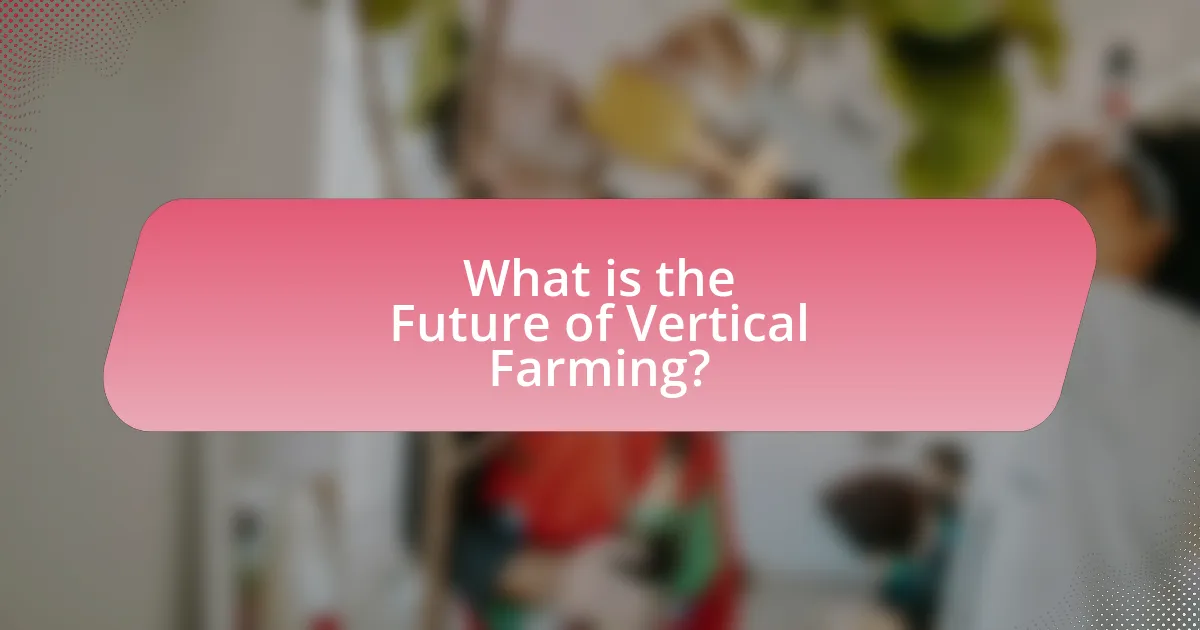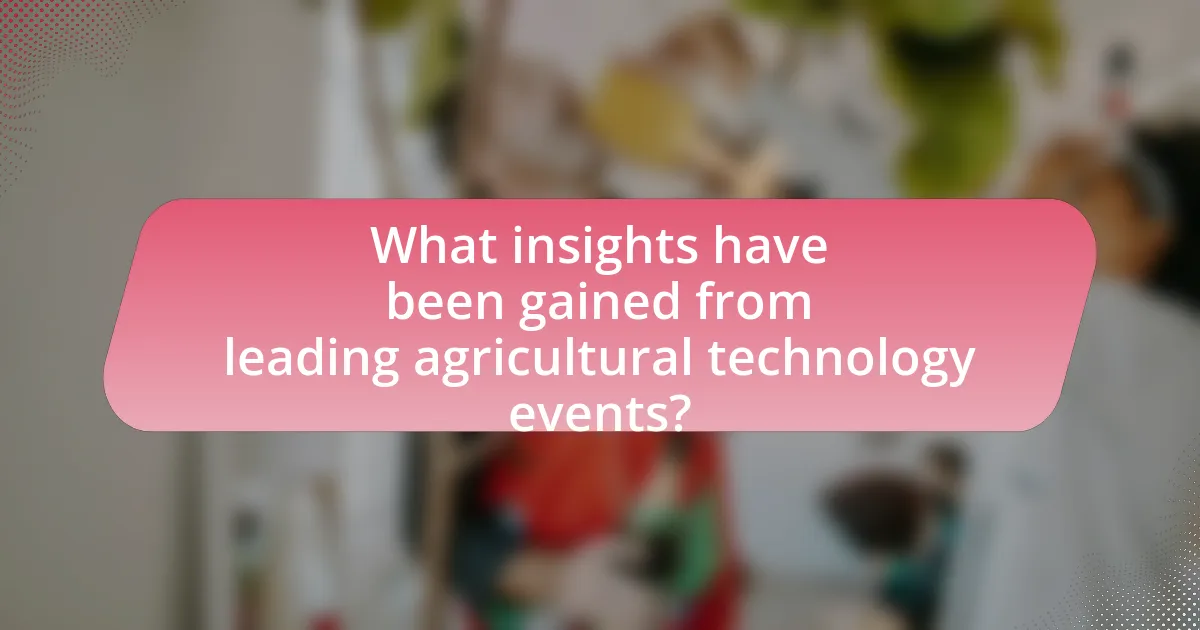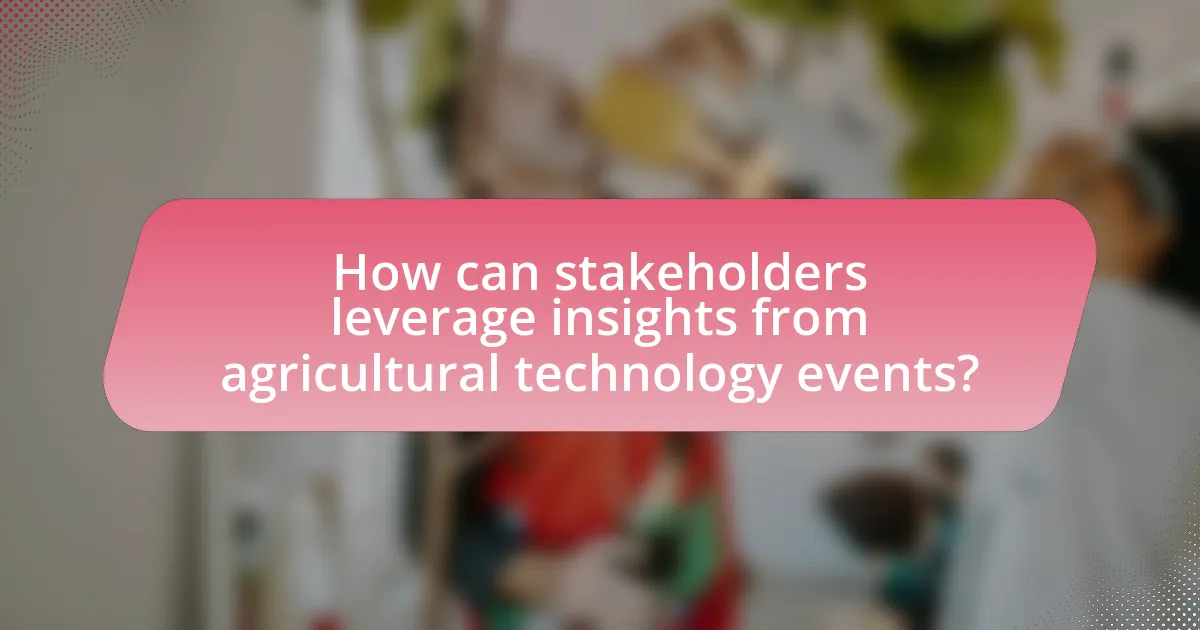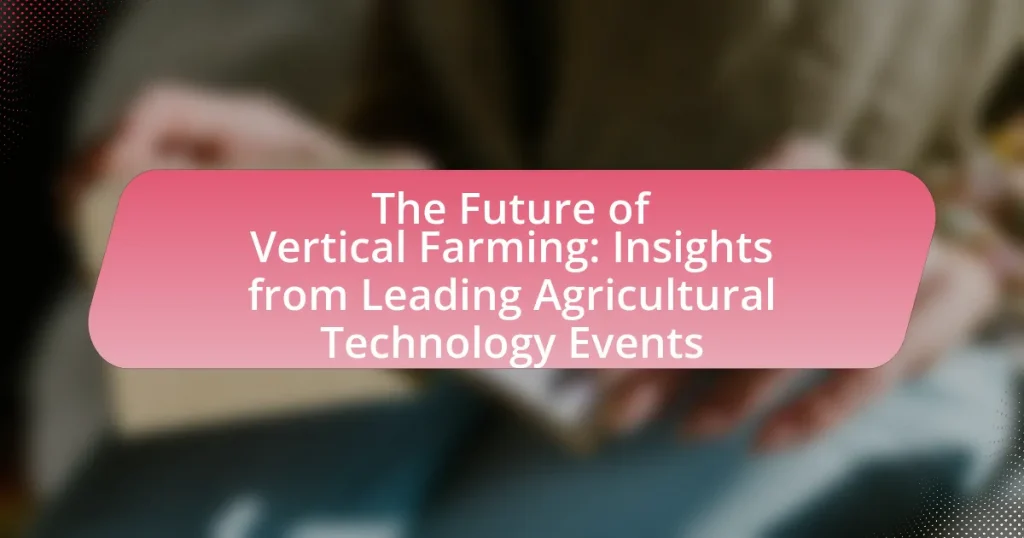The article focuses on the future of vertical farming, highlighting its potential for growth and innovation driven by technological advancements and the increasing demand for sustainable food production. It defines vertical farming as an efficient agricultural practice that utilizes vertically stacked layers to optimize space and resource management, significantly reducing land use and water consumption. Key technologies such as hydroponics, aeroponics, and advanced lighting systems are discussed, along with the differences between vertical and traditional farming methods. The article also addresses the challenges vertical farming solves in urban environments, its contributions to sustainability, and insights gained from leading agricultural technology events, emphasizing the importance of innovation and investment in this sector.

What is the Future of Vertical Farming?
The future of vertical farming is poised for significant growth and innovation, driven by advancements in technology and increasing demand for sustainable food production. As urban populations rise, vertical farming offers a solution to food security by enabling local food production in urban areas, reducing transportation costs and carbon footprints. According to a report by MarketsandMarkets, the vertical farming market is projected to reach $12.77 billion by 2026, growing at a CAGR of 24.8% from 2021. This growth is supported by developments in hydroponics, aeroponics, and artificial intelligence, which enhance crop yields and resource efficiency. Additionally, leading agricultural technology events highlight the integration of renewable energy sources and smart farming techniques, further solidifying vertical farming’s role in sustainable agriculture.
How is vertical farming defined in the context of modern agriculture?
Vertical farming is defined as an innovative agricultural practice that involves growing crops in vertically stacked layers or structures, often utilizing controlled-environment agriculture technology. This method enhances space efficiency and resource management, allowing for year-round production regardless of external climate conditions. According to a report by the Food and Agriculture Organization (FAO), vertical farming can significantly reduce land use and water consumption, making it a sustainable alternative to traditional farming methods.
What technologies are driving the evolution of vertical farming?
The technologies driving the evolution of vertical farming include hydroponics, aeroponics, and advanced lighting systems. Hydroponics allows plants to grow in nutrient-rich water without soil, significantly increasing yield and reducing resource use. Aeroponics enhances this by misting the roots with nutrient solutions, further optimizing growth conditions. Advanced lighting systems, particularly LED technology, provide the specific light spectra needed for photosynthesis while minimizing energy consumption. These technologies collectively enable higher productivity and sustainability in urban agriculture, addressing food security challenges in densely populated areas.
How does vertical farming differ from traditional farming methods?
Vertical farming differs from traditional farming methods primarily in its use of vertical space and controlled environments to grow crops. Unlike traditional farming, which relies on large expanses of land and natural weather conditions, vertical farming utilizes stacked layers and indoor settings, allowing for year-round production regardless of external climate. This method significantly reduces land usage by up to 90% and can increase crop yields by 10 to 20 times per square foot compared to conventional agriculture. Additionally, vertical farming often employs hydroponics or aeroponics, which use less water—up to 95% less than traditional farming—while minimizing pesticide use and reducing transportation emissions by locating farms closer to urban centers.
Why is vertical farming considered essential for future food security?
Vertical farming is considered essential for future food security because it enables the efficient production of food in urban environments, reducing reliance on traditional agriculture. This method utilizes controlled environments to optimize plant growth, significantly increasing yield per square foot compared to conventional farming. For instance, vertical farms can produce up to 10 times more food in the same area, while using 90% less water due to recirculation systems. Additionally, vertical farming minimizes transportation costs and carbon emissions by situating food production closer to urban populations, addressing the challenges posed by climate change and population growth.
What challenges does vertical farming address in urban environments?
Vertical farming addresses several challenges in urban environments, including limited space for traditional agriculture, food security, and resource efficiency. By utilizing vertical space, urban farms can produce food in densely populated areas, mitigating the issue of land scarcity. Additionally, vertical farming can enhance food security by providing fresh produce locally, reducing reliance on long supply chains that can be disrupted. Furthermore, these systems often use significantly less water and energy compared to conventional farming methods, as evidenced by studies showing that vertical farms can use up to 90% less water. This efficiency is crucial in urban settings where resources are often strained.
How does vertical farming contribute to sustainability and resource conservation?
Vertical farming significantly contributes to sustainability and resource conservation by utilizing space-efficient methods to grow crops, which reduces land use and minimizes environmental impact. This agricultural practice employs controlled environments that optimize water usage, often using up to 90% less water than traditional farming methods, as demonstrated by research from the University of California, Davis. Additionally, vertical farms can be located in urban areas, decreasing transportation emissions and providing fresh produce closer to consumers. The integration of renewable energy sources, such as solar power, further enhances the sustainability of vertical farming operations, reducing reliance on fossil fuels.

What insights have been gained from leading agricultural technology events?
Leading agricultural technology events have revealed critical insights into the advancements and challenges of vertical farming. These events highlight the integration of innovative technologies such as hydroponics, aeroponics, and artificial intelligence, which enhance crop yields and resource efficiency. For instance, the 2023 Indoor Ag-Con showcased systems that utilize 90% less water compared to traditional farming methods, demonstrating significant sustainability benefits. Additionally, discussions at these events emphasize the importance of data analytics in optimizing growth conditions, leading to improved productivity and reduced operational costs. The collective knowledge shared among industry leaders at these gatherings underscores the potential for vertical farming to address food security challenges in urban environments.
Which major agricultural technology events focus on vertical farming?
Major agricultural technology events that focus on vertical farming include the Indoor Ag-Con, the Vertical Farming World Congress, and the Global AgTech Innovation Summit. Indoor Ag-Con, held annually in Las Vegas, showcases innovations in indoor and vertical farming, featuring industry leaders and cutting-edge technologies. The Vertical Farming World Congress, which gathers experts from around the globe, emphasizes advancements and best practices in vertical farming systems. The Global AgTech Innovation Summit highlights the intersection of agriculture and technology, with a significant focus on sustainable practices, including vertical farming solutions. These events collectively contribute to the growth and development of vertical farming in the agricultural sector.
What key themes emerge from discussions at these events?
Key themes that emerge from discussions at agricultural technology events focused on vertical farming include sustainability, technological innovation, and economic viability. Sustainability is emphasized through practices that reduce resource consumption and environmental impact, such as water-efficient systems and renewable energy use. Technological innovation is highlighted by advancements in automation, artificial intelligence, and data analytics that enhance crop yield and operational efficiency. Economic viability is discussed in terms of market trends, investment opportunities, and the potential for vertical farming to meet urban food demands, supported by statistics indicating a projected growth in the vertical farming market to reach $12.77 billion by 2026.
How do industry leaders perceive the future of vertical farming?
Industry leaders perceive the future of vertical farming as a transformative solution for sustainable agriculture, driven by technological advancements and increasing urbanization. They highlight that vertical farming can significantly reduce land use and water consumption, with studies indicating that it uses up to 90% less water than traditional farming methods. Furthermore, industry experts emphasize the potential for vertical farms to produce food year-round, regardless of climate conditions, which addresses food security challenges. The global vertical farming market is projected to reach $12.77 billion by 2027, reflecting strong investment and interest in this innovative agricultural approach.
What innovations in vertical farming have been showcased at these events?
Innovations in vertical farming showcased at leading agricultural technology events include advanced hydroponic systems, automated growing environments, and AI-driven crop management tools. For instance, the integration of IoT sensors allows for real-time monitoring of plant health and environmental conditions, enhancing yield efficiency. Additionally, vertical farms are increasingly utilizing LED lighting technology that optimizes energy consumption while promoting plant growth, with studies indicating up to 30% energy savings compared to traditional methods. These advancements demonstrate a significant shift towards sustainable and efficient agricultural practices in urban settings.
What role do startups play in advancing vertical farming technologies?
Startups play a crucial role in advancing vertical farming technologies by driving innovation and developing scalable solutions. They often focus on niche areas within vertical farming, such as automation, hydroponics, and data analytics, which allows them to rapidly prototype and test new ideas. For instance, companies like Plenty and Bowery Farming have introduced advanced growing systems that utilize artificial intelligence to optimize plant growth and resource use. This innovation is supported by significant investment; in 2021 alone, vertical farming startups raised over $1 billion in funding, demonstrating strong investor confidence in their potential to transform agriculture.
How are established companies adapting to the vertical farming trend?
Established companies are adapting to the vertical farming trend by investing in technology and forming partnerships to enhance their agricultural practices. For instance, companies like Philips and AeroFarms are integrating advanced LED lighting and automation systems to optimize plant growth in controlled environments. Additionally, major agricultural firms such as Bayer and Cargill are collaborating with vertical farming startups to leverage innovative techniques and expand their product offerings. This shift is supported by market research indicating that the global vertical farming market is projected to reach $12.77 billion by 2026, highlighting the increasing interest and investment in this sector.

How can stakeholders leverage insights from agricultural technology events?
Stakeholders can leverage insights from agricultural technology events by actively engaging in networking opportunities and adopting innovative practices showcased during these events. By participating in discussions and workshops, stakeholders gain access to the latest advancements in technology, such as precision agriculture tools and vertical farming techniques, which can enhance productivity and sustainability. For instance, events like the International Conference on Vertical Farming provide case studies and expert panels that highlight successful implementations, allowing stakeholders to benchmark their strategies against industry leaders. This direct exposure to cutting-edge research and practical applications enables stakeholders to make informed decisions that align with emerging trends and consumer demands in the agricultural sector.
What best practices can be derived from the insights shared at these events?
Best practices derived from insights shared at leading agricultural technology events include the implementation of advanced data analytics for optimizing crop yields, the adoption of sustainable resource management techniques, and the integration of automation technologies to enhance operational efficiency. For instance, utilizing precision agriculture tools allows farmers to monitor environmental conditions and crop health in real-time, leading to informed decision-making that can increase productivity by up to 20%. Additionally, sustainable practices such as hydroponics and aeroponics reduce water usage by 90% compared to traditional farming methods, demonstrating significant resource conservation. These practices are validated by case studies presented at events like the Indoor Ag-Con and the Vertical Farming World Congress, where industry leaders showcased successful applications and measurable outcomes.
How can farmers implement new technologies in their vertical farming operations?
Farmers can implement new technologies in their vertical farming operations by integrating advanced systems such as hydroponics, aeroponics, and automated climate control. These technologies enhance crop yield and resource efficiency, as evidenced by studies showing that hydroponic systems can produce up to 30% more crops than traditional soil farming while using 90% less water. Additionally, farmers can utilize data analytics and IoT devices to monitor plant health and optimize growth conditions in real-time, leading to improved productivity and reduced operational costs. Implementing these technologies not only modernizes farming practices but also aligns with sustainability goals, as vertical farms can significantly reduce the carbon footprint associated with food production.
What strategies can investors use to support vertical farming initiatives?
Investors can support vertical farming initiatives by providing capital for technology development, engaging in partnerships with existing farms, and investing in research and development for sustainable practices. Capital investment enables the acquisition of advanced systems such as hydroponics and automation, which enhance efficiency and yield. Partnerships with established vertical farms can facilitate knowledge sharing and operational improvements, while funding research can lead to innovations that reduce costs and environmental impact. For instance, a report by the Food and Agriculture Organization indicates that vertical farming can reduce water usage by up to 90% compared to traditional farming, highlighting the potential for sustainable investment returns.
What are the future trends in vertical farming to watch for?
Future trends in vertical farming include increased automation, integration of artificial intelligence, and advancements in hydroponic and aeroponic systems. Automation is expected to enhance efficiency and reduce labor costs, with technologies such as robotics and automated nutrient delivery systems becoming more prevalent. The integration of artificial intelligence will enable data-driven decision-making, optimizing growth conditions and resource usage. Additionally, innovations in hydroponic and aeroponic systems will improve crop yields and reduce water usage, addressing sustainability concerns. According to a report by MarketsandMarkets, the vertical farming market is projected to grow from $3.1 billion in 2020 to $12.77 billion by 2026, highlighting the increasing investment and interest in these technologies.
How might consumer preferences shape the development of vertical farming?
Consumer preferences significantly shape the development of vertical farming by driving demand for locally sourced, fresh, and sustainable produce. As consumers increasingly prioritize health, environmental sustainability, and food transparency, vertical farming systems are adapting to meet these needs. For instance, a survey by the Food Marketing Institute found that 70% of consumers are willing to pay more for locally grown food, prompting vertical farms to focus on urban locations to reduce transportation emissions and enhance freshness. Additionally, the rise in demand for organic produce has led vertical farms to implement organic growing practices, aligning with consumer values and preferences. This alignment not only influences the types of crops grown but also the technologies adopted, such as hydroponics and aeroponics, which cater to the desire for pesticide-free options.
What regulatory changes could impact the vertical farming landscape?
Regulatory changes that could impact the vertical farming landscape include modifications to zoning laws, food safety regulations, and environmental standards. Zoning laws may evolve to facilitate the establishment of vertical farms in urban areas, allowing for increased accessibility to fresh produce. Food safety regulations could become more stringent, requiring vertical farms to implement advanced traceability and hygiene practices, which may increase operational costs. Additionally, environmental standards may be updated to promote sustainable practices, such as energy efficiency and water conservation, influencing the design and operation of vertical farming systems. These changes are driven by the growing demand for local food production and sustainability, as evidenced by initiatives in cities like New York and Singapore that aim to integrate urban agriculture into their planning frameworks.
What practical steps can be taken to succeed in vertical farming?
To succeed in vertical farming, implement efficient resource management, optimize crop selection, and utilize advanced technology. Efficient resource management involves minimizing water and energy usage, as vertical farms can use up to 90% less water than traditional farming methods. Optimizing crop selection means choosing high-yield, fast-growing plants that are well-suited for indoor environments, such as leafy greens and herbs. Utilizing advanced technology includes integrating automation, LED lighting, and climate control systems to enhance growth conditions and reduce labor costs. These steps are supported by studies indicating that vertical farming can achieve up to 10 times the yield per square foot compared to conventional agriculture, making it a viable solution for urban food production.















